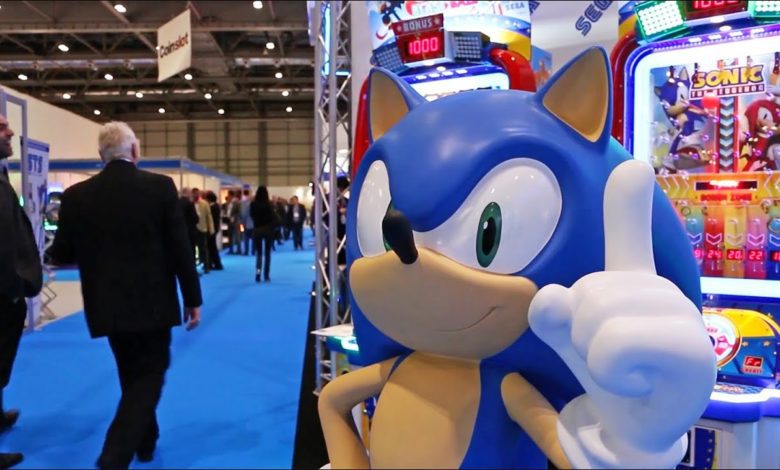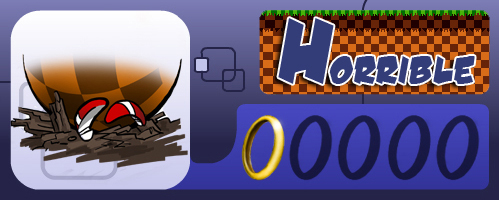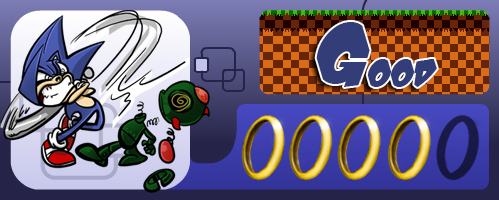
Retro Review: Sonic Adventure
Good grief. Now I’m going to try and fairly review Sonic Adventure, one of the most divisive games in SEGA’s back-catalogue. While it was received very well upon its original release in 1999, its many flaws have been exhaustively laid out since. How to proceed? Should I once again lay out all of those apparent flaws along with each of its redeeming factors, risking certain boredom for all SEGA fans already intimately familiar with the game?
Yep! But not in paragraph form, at least. That’s right, bucking the trend and putting the PROS and CONS right up front!

PROS:
+ Still looks pretty
+ Stellar tunes
+ Flashes of brilliance
+ Plot ain’t half bad
+ Variety of gameplay
+ Great use of VMU
CONS:
– Bad camera issues
– Too much playing as Sonic’s friends
– Glitches aplenty
– Hub world fetch quests artificially extend game time
– Pretty easy compared to previous Sonic games
– Cheesy voice acting, love it or hate it
Now where do we go from here? I’m sure most of you have played Sonic Adventure and have read the above arguments several times, but you’ve already made your own judgement about the game as a whole. I’d like to specifically mention PRO #5, though, “Variety of Gameplay,” because while there is certainly an adventure element to Sonic Adventure overall, there are so many different ways to play that you could almost classify the game as a minigame collection. Think about it, inside the game is a kart racer, a fishing game, a whack-a-mole game, a rail shooter, two pinball tables, a downhill snowboarding race, even a creature raising simulator using the VMU with its own subset of minigames.
Therefore, instead of doing a full write up of Sonic Adventure as a whole, I’m going to mini-review two very specific moments in the game, those that I think represent the its best and worst aspects, starting with the latter.

“Can’t hold on much longer…”
So what’s the worst part of Sonic Adventure? I’m sure many of you will scream “Big the Cat! It’s everything Big the Cat!” And while Big’s stages are rough and they do seriously break the pace of the game, the minigame itself is a passable, albeit lackluster fishing game. It’s not spectacular, but it’s playable enough as a fishing game when considered on its own. It just doesn’t offend me much other than being out of place.
No, the worst part of Sonic Adventure is actually tied to one of Sonic’s stages. “Heresy!” you say? “Sonic’s game is the best part!” Let me ask you something: How much time have you spent in stage 3, Casinopolis? Because those pinball minigames are just plain awful.

Casinopolis is a rather small stage requiring you to collect a huge pile of rings and build a mountain of them big enough to reach Robotnik’s badnik generator at the end of the stage. If the fetch quest nature of the stage wasn’t annoying enough, the primary way to collect rings in this stage is to play one of two pinball games, a Sonic the Hedgehog table and a NiGHTS into Dreams table.
“Hey that sounds awesome, Requiem!” You might say. “You suck for hating such amazing fan service!”
Well, ladies and gentlemen, I may suck, but it’s for a longer and very different list of reasons.
In theory, there certainly isn’t anything wrong with including a pinball minigame in Sonic Adventure. Pinball has been a part of Sonic’s roots from the very beginning, from Spring Yard Zone in Sonic’s first Genesis outing to Sonic Spinball, a full pinball game starring the blue blur.
These two pinball tables in Sonic Adventure, however, are almost completely broken. Beyond the delightful aesthetics of the tables (especially the NiGHTS table), they’re excruciating and nearly unplayable. Sonic’s (the ball’s) physics are totally off. His movement is beyond slow and floaty, and he never really seems to gain any sense of inertia.

The tables themselves are also extremely poorly-designed. Just look at the Sonic table for a second. See how vacant it is? The mid-section is pretty much entirely empty. Sure, the slot machine makes it look as though there is something there, but the goal for triggering that is way up at the top of the table, and your success in getting rings that way is just as random as hitting the jackpot on a regular slot machine- totally up to chance with no skill involved.
The NiGHTS table is a bit better, but just a bit. The lower portion has a little bit more going on as far as ramps and more distinct goals, and you can advance to an upper portion where you target a set of playing cards and try to create “matches” in a five-card hand to get big ring bonuses. It’s also definitely cool to have the NiGHTS tunes pumping in the background and seeing NiGHTS himself twirling about during the transitions between the lower and upper sides of the play field.
Unfortunately, this very same fan service that makes this table so interesting is also its downfall, in a way, in that these transitions take too. damn. long. You have to watch the same transitions over and over, they last several seconds, there is no way to skip them, and once you’ve seen them a few times, the shine dulls immensely.

All things considered, it is with great trepidation that I say that Sonic Adventure‘s pinball tables may be the worst video pinball I’ve ever played. Ever. Even games as old as say, Midnight Magic on Atari 2600 or PinBot on NES are more playable despite their technological limitations.
The sad thing is that there really isn’t much excuse for these pinball tables being so bad. SEGA had their own arcade pinball division for several years, and they have quite a pedigree in developing halfway decent video pinball games as well, both before and since (Sonic Spinball, The Pinball of the Dead, Sonic Pinball Party). All it would have taken would have been for someone at Sonic Team to find any of those folks and say “Hey, so… take a look at these tables for two minutes and tell me what you think.” It wouldn’t even have taken the full two minutes to realize how bad they were.
Unfortunately, you have to master the NiGHTS table in order to complete the more advanced ranking challenges in the game, in that collecting enough rings within the time allotted is pretty tough, maybe impossible, otherwise. If you don’t care about that, then I suggest that once you trudge through Casinopolis Zone that you never look back, and instead play Sonic Spinball on Genesis or Sonic Pinball Party on GBA if you really need a Sonic video pinball fix.

PROS:
+ NiGHTS fan service
+ Decent music
+ Card collecting isn’t not fun
+ The whole rest of the game is better
CONS:
– Ball physics suck balls
– Table layouts are empty & suck immensely
– Transitions take waaay too long (& start to suck)
– Few skill based challenges (might be a “PRO” if you suck)
– All part of a larger, sucky fetch quest
– Worst. Video. Pinball. Ever.
Casinopolis Video Pinball Tables
“…But I will never let go…”
Moving on to where Sonic Adventure really shines. There are admittedly a lot of things to look at when considering what the overall best part of the game is. I’m one who actually enjoyed the “adventure” elements of the Hub world, there are many awesome “moments” in several of the action stages (like running down the side of a building in Speed Highway), and while I never delved too deeply into the chao raising VMU mini-games, I know a lot of people sunk a lot of time into that aspect of the game and it is a rather deep addition to Sonic Adventure all on its own.

For me though, Sonic Adventure is at its very best in Sonic’s second action stage, Windy Valley. The stage layout is interesting, the music is great, the hardware gets a few great opportunities to show off a bit, and Sonic gets to go blisteringly fast without the entire stage feeling too much like “press forward to win.”
From a stage layout perspective, Windy Valley is both evocative of Sonic’s early Genesis games as well as adept at cleverly tying 3D advances into the world. Stages from the original Sonic games have a sense of verticality to them that many other platforming games from the time lacked, and Windy Valley is one of a very few stages in Sonic Adventure where that sense of verticality is replicated. No, you don’t have as many branching paths as you do in the Genesis games, but Windy Valley certainly doesn’t exist on a flat playing field and the 3D space is employed very well.

There are also some very interesting transitions between parts of the stages, too. About halfway through the stage, the environment will be destroyed by a giant tornado, sucking Sonic into it. Your task is then to jump so high up that you escape the tornado from the very top, and when you do, the camera changes to an overhead perspective as you aim your descent to negotiate platforms below you. If you ever played the original Jumping Flash! on the Sony PlayStation, it’s a lot like that without the barf-ugly garbage that was early 3D graphics. Baaaarrrf!
(Note: ugliness aside, I loved Jumping Flash! Damn Sony for making me care about one of their games!)
Each part of the stage feels unique, and arguably more so than any other stage does Windy Valley influence the stage design of future Sonic titles.You return to it with a few of the other characters in the game, which is nice, but the stage was clearly designed with Sonic in mind.
It’s hard to criticize a single stage on its own. Do you fault it for issues that affect the game as a whole? I’m going to have to say yes, and in that case I can’t say that the stage is an excellent 5 out of 5. It’s close. It’s damn good. However, the camera is still a bit off in a couple of areas, and your homing attack throws you in some weird directions at times, several of those times resulting in the loss of a life. These issues don’t break the stage, but they keep Windy Valley from being as stellar as it could be.

Over the years, Windy Valley has become a favorite of mine to revisit for the purposes of speed runs even after completing all of the challenges for the game, much like Ice Cap Zone in Sonic the Hedgehog 3. It’s still a fun romp despite how many times I play it. I know it may seem pessimistic to say that the game peaks in the second stage, but there is still plenty left to look forward to after you complete Windy Valley. For instance, you get to play Windy Valley twice more to complete the more difficult challenges!
PROS:
+ Great variety of gameplay
+ Good use of 3D space & verticality
+ Nice doses of speed & spectacle
+ Fun transitions
+ Awesome for speed runs
CONS:
– Revisiting with other characters not as satisfying
– Camera & glitch issues persist
Windy Valley Zone
“Open your heart, it’s gonna be all right!”
That brings me to the end, fellow SEGA nerds. I have a feeling that you already know how you feel about Sonic Adventure. If you don’t, and you were coming to the site hoping for the definitive, exhaustive examination of the game before making a purchase, well, I’m sorry. Honestly though, the game is available digitally on Steam, Xbox 360 and PlayStation 3 for just five bucks, and for just a few bucks more you can upgrade it to the prettier, more feature-rich GameCube DX version, which I do recommend.

Oh, but I can hear it now. “You suck, Requiem! You’re such a cop-out! You’re just scared to make a stand one way or another on a controversial game!” To those of you, I say, “Au contraire, bitches! You are the ones who suck!” But you know what? Fine. Here’s my assessment of the game if you haven’t played it for yourselves already…
If you are a fan of Sonic, SEGA, or retro gaming in general, then I definitely recommend that drop $5 on your digital platform of choice and try Sonic Adventure. If you are a random modern gamer who somehow stumbled upon our humble journalist-ish site with no presuppositions, no prior standing love for SEGA or Sonic, then you will probably find Sonic Adventure to be a pretty “meh” game, filled almost equally with moments of brilliance and tedium.
Sonic Adventure Overall Score
There you go. Three out of five. Can’t get much more cop-out than that!
Happy 15th Anniversary, SEGA Dreamcast!
http://youtu.be/q5EFVDBW-F4
*Note: some of the images collected in this article come from the upgraded DX version of the game on Xbox 360.




